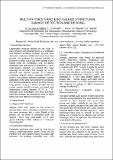Multi-Physics Nano-Engineered Structural Damage Detection and De-Icing
Author(s)
Guzman de Villoria, Roberto; Kessler, Seth S.; Wicks, Sunny S.; Miravete, Antonio; Wardle, Brian L.
DownloadICCM18_rguzman_NDE.pdf (208.7Kb)
OPEN_ACCESS_POLICY
Open Access Policy
Creative Commons Attribution-Noncommercial-Share Alike
Terms of use
Metadata
Show full item recordAbstract
Catastrophic structural failures are the cause of many physical and personal losses, at a worldwide cost estimated at billions of dollars per year. Non-destructive evaluation (NDE) techniques have been pursued and employed for damage detection of structures to detect cracks and other damage at pre-critical levels for remediation [1-3]. To address drawbacks with state-of-the-art approaches, a novel multi-physics approach is reported that takes advantage of the effects that damage has on the electrical and thermal transport in a material containing aligned carbon nanotubes (CNTs) to create a new damage detection technique. Another application of the same nano-engineered composites is in thermal applications such as de-icing and anti-icing systems. Icing is a serious problem that has caused several aircraft incidents associated with temperatures ranging between -40 ºC to 0 ºC. Although some technologies have been developed, improved solutions are desirable in order to obtain lighter and more efficient technologies
Date issued
2011-08Department
Massachusetts Institute of Technology. Department of Aeronautics and AstronauticsJournal
Proceedings of the 18th international conference on Composite Materials (ICCM), 2011
Citation
Guzmán de Villoria, R., Kessler, S.S., Yamamoto, N., Miravete, A., and B.L. Wardle, “Multi-Physics Nano-engineered Structural Damage Detection and De-icing,” 18th International Conference on Composite Materials (ICCM), Jeju Island, South Korea, Aug. 21-26, 2011.
Version: Author's final manuscript